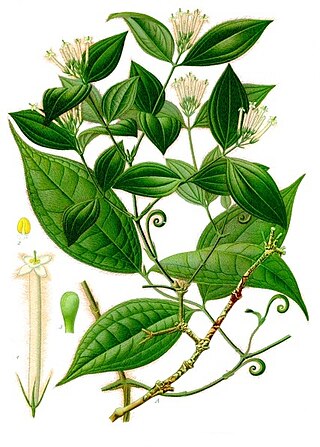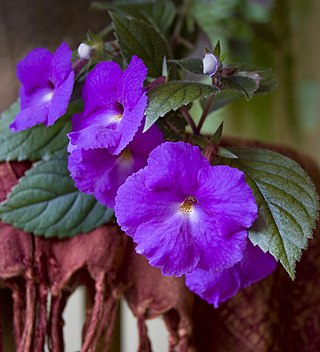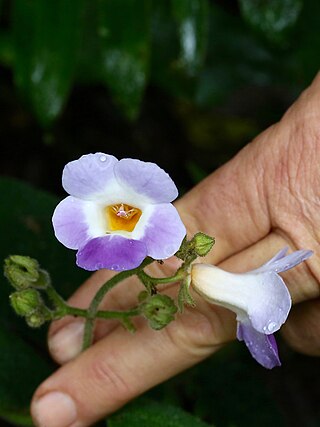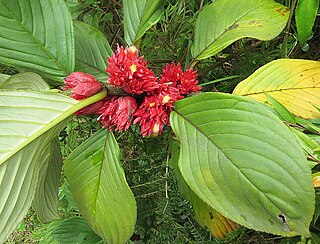
Nepeta is a genus of flowering plants in the family Lamiaceae. The genus name is reportedly in reference to Nepete, an ancient Etruscan city. There are about 250 species.

Buddleja is a genus comprising over 140 species of flowering plants endemic to Asia, Africa, and the Americas. The generic name bestowed by Linnaeus posthumously honoured the Reverend Adam Buddle (1662–1715), an English botanist and rector, at the suggestion of Dr. William Houstoun. Houstoun sent the first plants to become known to science as buddleja to England from the Caribbean about 15 years after Buddle's death.

Strychnos is a genus of flowering plants, belonging to the family Loganiaceae. The genus includes about 100 accepted species of trees and lianas, and more than 200 that are as yet unresolved. The genus is widely distributed around the world's tropics and is noted for the presence of poisonous indole alkaloids in the roots, stems and leaves of various species. Among these alkaloids are the well-known and virulent poisons strychnine and curare.

Carissa is a genus of shrubs or small trees native to tropical and subtropical regions of Africa, Australia and Asia. Until recently about 100 species were listed, but most of them have been relegated to the status of synonyms or assigned to other genera, such as Acokanthera.

Calliandra is a genus of flowering plants in the pea family, Fabaceae, in the mimosoid clade of the subfamily Caesalpinioideae. It contains about 140 species that are native to tropical and subtropical regions of the Americas.

Episcia is a genus of flowering plants in the African violet family, Gesneriaceae. The ten species it contains are native to the tropical regions of Central and South America. The species are perennial herbaceous plants characterized by a stoloniferous habit, red flowers, and frequently have marked or patterned leaves. Episcias are sometimes called flame violets.

Columnea is a genus of around 200 species of epiphytic herbs and shrubs in the family Gesneriaceae, native to the tropics of the Americas and the Caribbean. The tubular or oddly shaped flowers are usually large and brightly colored – usually red, yellow, or orange – sometimes resembling a fish in shape. A common name is flying goldfish plants due to the unusual flower shape.

Achimenes is a genus of about 25 species of tropical and subtropical rhizomatous perennial herbs in the flowering plant family Gesneriaceae. They have a multitude of common names such as magic flowers, widow's tears, Cupid's bower, or hot water plant.

Leucaena is a genus of flowering plants in the mimosoid clade of the subfamily Caesalpinioideae of the family Fabaceae. It contains about 24 species of trees and shrubs, which are commonly known as leadtrees. They are native to the Americas, ranging from Texas in the United States south to Peru. The generic name is derived from the Greek word λευκός (leukos), meaning "white," referring to the flowers.

Kohleria is a New World genus of the flowering plant family Gesneriaceae. The plants are generally tropical herbs or subshrubs with velvety stems and foliage and brightly colored flowers with spots or markings in contrasting colors. They are rhizomatous and commonly include a period of dormancy in their growth cycle. The genus was revised in 1992 and was then recognized as having 19 species distributed in Central America and South America. phylogenetic in 2005 indicated that the epiphytic genus Capanea is derived from within Kohleria, and the two species of Capanea were subsequently transferred to Kohleria. The genus Pearcea is closely related.

Sinningia is a genus of flowering plants in the family Gesneriaceae. It is named after Wilhelm Sinning (1792–1874), a gardener of the Botanische Gärten der Friedrich-Wilhelms-Universität Bonn. There are about 65 species of tuberous herbaceous perennials, all occurring in Central and South America, with the greatest concentration of species occurring in southern Brazil.
Malouetia is a genus of plants in the family Apocynaceae, first described as a genus in 1844. It is native to Africa, South America, Central America, and the West Indies.

Monopyle is a genus of plants in the family Gesneriaceae.

Nautilocalyx is a genus of plants in the family Gesneriaceae. Its native range stretches from Costa Rica to southern Tropical America and to Trinidad. It is also found in Bolivia, Brazil, Colombia, Costa Rica, Ecuador, French Guiana, Guyana, Panamá, Peru, Suriname, Trinidad-Tobago and Venezuela.
Anthonius Josephus Maria "Toon" Leeuwenberg was a Dutch botanist and taxonomist best known for his research into the genus Buddleja at the Laboratory of Plant Taxonomy and Plant Geography, Wageningen. He was responsible for sinking many Asiatic species as varieties, notably within Buddleja crispa. In 1962, he worked with Jan de Wilde on the flora of the Ivory Coast.

Rauvolfioideae is a subfamily of the flowering plant family Apocynaceae. Many species are woody lianas, others are shrubs or perennial herbs.

Mesechites is a genus of plants in the family Apocynaceae first described as a genus in 1860. It is native to Mexico, Central America, South America, and the West Indies.
- Mesechites acuminatus Müll.Arg. - Peru
- Mesechites angustifolius(Poir.) Miers - Hispaniola
- Mesechites citrifolius(Kunth) Woodson - Colombia
- Mesechites mansoanus(A.DC.) Woodson - Paraguay, Brazil
- Mesechites minimus(Britton & P.Wilson) Woodson - Cuba
- Mesechites repens(Jacq.) Miers - Hispaniola, Navassa Island, Jamaica
- Mesechites roseus(A.DC.) Miers - Cuba
- Mesechites trifidus(Jacq.) Müll.Arg. - widespread from Tamaulipas in NE Mexico south to Paraguay + N Argentina
- Mesechites andrieuxii(Müll.Arg.) Miers = Mandevilla convolvulacea(A.DC.) Hemsl.
- Mesechites angustatusMiers = Mandevilla benthamii(A.DC.) K.Schum.
- Mesechites brownei(A.DC.) Miers = Mandevilla torosa(Jacq.) Woodson
- Mesechites dichotomus(Kunth) Miers = Laubertia boissieriA.DC.
- Mesechites guayaquilensisMiers = Mandevilla subsagittata(Ruiz & Pav.) Woodson
- Mesechites guianensis(A.DC.) Miers = Mandevilla rugellosa(Rich.) L.Allorge
- Mesechites hastatusMiers = Mandevilla subsagittata(Ruiz & Pav.) Woodson
- Mesechites hirtellulusMiers = Mandevilla oaxacana(A.DC.) Hemsl.
- Mesechites hirtellus(Kunth) Miers = Mandevilla subsagittata(Ruiz & Pav.) Woodson
- Mesechites jasminiflorus(M.Martens & Galeotti) Miers = Mandevilla subsagittata(Ruiz & Pav.) Woodson
- Mesechites lanceolatus(R.Br.) Miers = Parsonsia lanceolataR.Br.
- Mesechites oaxacanus(A.DC.) Miers = Mandevilla oaxacana(A.DC.) Hemsl.
- Mesechites ovalis(Ruiz & Pav. ex Markgr.) Pichon = Allomarkgrafia ovalis(Ruiz & Pav. ex Markgr.) Woodson
- Mesechites plumeriiflorus(Woodson) Pichon = Allomarkgrafia plumeriifloraWoodson
- Mesechites siphiliticus(L.f.) Lemée = Tabernaemontana siphilitica(L.f.) Leeuwenb.
- Mesechites subcarnosus(Benth.) Miers = Mandevilla subcarnosa(Benth.) Woodson
- Mesechites sulphureus(Vell.) Müll.Arg. = Prestonia coalita(Vell.) Woodson
- Mesechites torulosus(L.) Miers =Mandevilla torosa(Jacq.) Woodson

Glossoloma is a genus of Neotropical plants in the family Gesneriaceae. The species in the genus were formerly placed in Alloplectus. They are subshrubs with the leaves clustered at the ends of branches, and tubular flowers.

Solenophora is a genus of flowering plants in the family Gesneriaceae, native to Central America and southern Mexico. Most of its species have limited, local distributions, but Solenophora calycosa is widespread.
Centrosolenia is a genus of flowering plants belonging to the family Gesneriaceae.

















